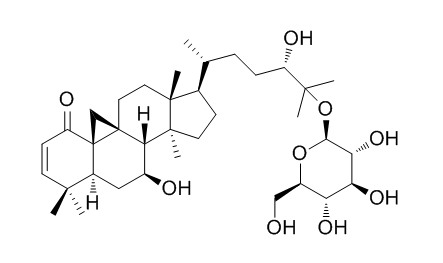Sutherlandioside D
Sutherlandioside D may exert anti-cancer effect by targeting Gli/Hh signaling.
Inquire / Order:
manager@chemfaces.com
Technical Inquiries:
service@chemfaces.com
Tel:
+86-27-84237783
Fax:
+86-27-84254680
Address:
1 Building, No. 83, CheCheng Rd., Wuhan Economic and Technological Development Zone, Wuhan, Hubei 430056, PRC
Providing storage is as stated on the product vial and the vial is kept tightly sealed, the product can be stored for up to
24 months(2-8C).
Wherever possible, you should prepare and use solutions on the same day. However, if you need to make up stock solutions in advance, we recommend that you store the solution as aliquots in tightly sealed vials at -20C. Generally, these will be useable for up to two weeks. Before use, and prior to opening the vial we recommend that you allow your product to equilibrate to room temperature for at least 1 hour.
Need more advice on solubility, usage and handling? Please email to: service@chemfaces.com
The packaging of the product may have turned upside down during transportation, resulting in the natural compounds adhering to the neck or cap of the vial. take the vial out of its packaging and gently shake to let the compounds fall to the bottom of the vial. for liquid products, centrifuge at 200-500 RPM to gather the liquid at the bottom of the vial. try to avoid loss or contamination during handling.
Int J Mol Sci. 2014, 15(5):8443-57
Pharmaceutics.2020, 12(9):882.
J Liq Chromatogr R T2025, 2505536.
RSC Adv.2024, 14(40):29319-29329.
Onco Targets Ther.2017, 10:3467-3474
Proc Biol Sci.2024, 291(2015):20232578.
Appl. Sci.2021, 11(19),9343.
Korean J. Food Preserv.2023, 30(4):663-668.
Sci Rep.2024, 14(1):31213.
Pak J Pharm Sci.2023, 36(1):51-57.
Related and Featured Products
Cell Biology International, 2015, 40(2).
Inhibition of Gli/hedgehog signaling in prostate cancer cells by “cancer bush” Sutherlandia frutescens extract.[Reference:
WebLink]
Sutherlandia frutescens is a medicinal plant, traditionally used to treat various types of human diseases, including cancer. Previous studies of several botanicals link suppression of prostate cancer growth with inhibition of the Gli/hedgehog (Gli/Hh) signaling pathway.
METHODS AND RESULTS:
Here we hypothesized the anti-cancer effect of S. frutescens was linked to its inhibition of the Gli/Hh signaling in prostate cancer. We found a dose- and time-dependent growth inhibition in human prostate cancer cells, PC3 and LNCaP, and mouse prostate cancer cell, TRAMP-C2, treated with S. frutescens methanol extract (SLE). We also observed a dose-dependent inhibition of the Gli-reporter activity in Shh Light II and TRAMP-C2QGli cells treated with SLE. In addition, SLE can inhibit Gli/Hh signaling by blocking Gli1 and Ptched1 gene expression in the presence of a Gli/Hh signaling agonist (SAG). A diet supplemented with S. frutescens suppressed the formation of poorly differentiated carcinoma in prostates of TRAMP mice. Finally, we found Sutherlandioside D was the most potent compound in the crude extract that could suppress Gli-reporter in Shh Light II cells.
CONCLUSIONS:
Together, this suggests that the S. frutescens extract may exert anti-cancer effect by targeting Gli/Hh signaling, and Sutherlandioside D is one of the active compounds.
Planta Medica, 2009, 75(04):s-2009-1216513.
Quantitative Determination of Cycloartane and Flavonoid Glycosides from Sutherlandia frutescens by UPLC-UV, UPLC-ELSD Methods and Confirmation by UPLC-MS.[Reference:
WebLink]
METHODS AND RESULTS:
Sutherlandia frutescens (L.) R. BR., Family Fabaceae, is a well-known and widely used medicinal plant from the Western Cape, South Africa [1,2]. Traditionally it has been used as a remedy for stomach problems, internal cancers, diabetes and various inflammatory conditions. Recently, it has been used for the management of HIV/AIDS in patients [1]. This paper describes the analytical method suitable for the determination of four flavonoid glycosides (Sutherlandin A, B, C, D) and four cycloartane glycosides (Sutherlandioside A, Sutherlandioside B, Sutherlandioside C, Sutherlandioside D) from stem-leaves of Sutherlandia frutescens (L.) R. BR. A separation by UPLC was achieved by using Acquity shield RP18 column, PDA with ELS detection, and a water/acetonitrile gradient as the mobile phase. The major cycloartane glycoside compound (sutherlandioside B) was detected at a concentration as low as 1.0 µg/mL. The analysis of plant material and products showed considerable variation of 0.6–2.7% for the major compound. This method involved the use of the [M+H]+ and [M+Na]+ ions in the positive ion mode with extractive ion monitoring (EIM).
CONCLUSIONS:
The eight compounds were further confirmed by UPLC-MS method in plant sample and products. In the positive ion mode, the protonated species [M+H]+ at m/z 741.2, 741.2, 725.2, 725.2, 653.4, 651.4, 635.4 and 653.4 and sodiated species [M+Na]+ at m/z 763.2, 763.2, 747.2, 747.2, 675.4, 673.4, 657.4 and 675.4 for compounds 1–8 were observed.



